In anticipation of Halloween, we’re highlighting the spookiest destinations to travel to, excerpted from the New York Times bestseller Atlas Obscura.
Check out the Atlas Obscura book, calendars, and journal here!
1. Musée Fragonard
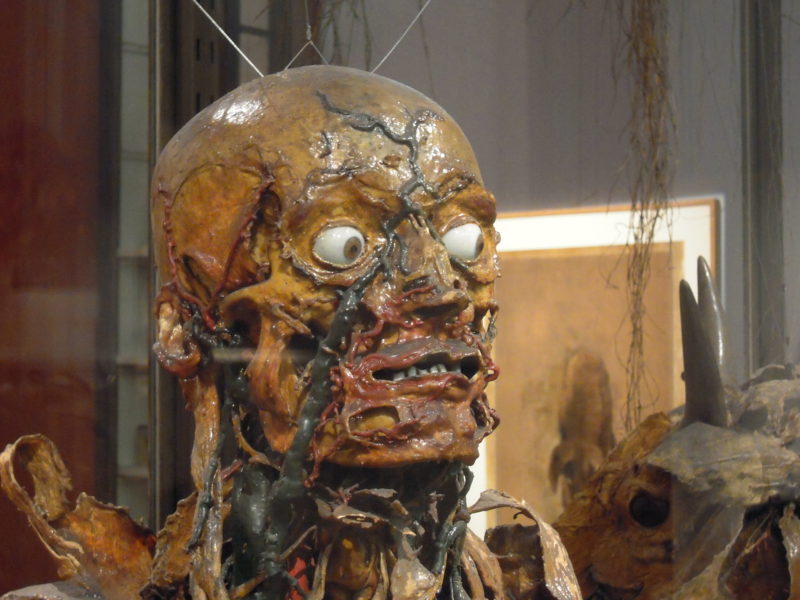
PARIS, FRANCE
At the Musée Fragonard, human fetuses dance a jig alongside a 10-legged sheep while a skinless horseman of the apocalypse looks on.
Founded in 1766 as a veterinary school with a private collection, the museum has rooms devoted to anatomy, physical abnormalities, articulated animal skeletons, and disease. However, by far the most striking room is the collection of écorchés, or “flayed figures,” created by Honoré Fragonard.
Louis XV appointed Fragonard as a professor at the first veterinary school in Lyon and, it was there that he began skinning and preserving animal and, later, human corpses. Though he intended for his écorchés to be used as educational tools, Fragonard arranged many of his figures into theatrical poses, creating eerie posthumous narratives. The horseman of the apocalypse, inspired by Albrecht Dürer’s painting, is the most notable example. A skinless corpse with dried, varnished muscles and unnerving glass eyes sits astride a similarly preserved horse caught mid-gallop, the thick arteries of its neck filled with red wax. Reins loop from the animal’s mouth and over the rigid sinew of the rider’s hands.
Fragonard worked in Lyon for six years before his flayed figures began frightening the townspeople. He was dismissed from the institution amid accusations of insanity. The public would not see the flayed figures until the Fragonard museum opened in 1991.
7, avenue de Général de Gaulle, Maisons-Alfort. Located in a suburb of Paris, you can take the Métro to École Veterinaire de Maisons-Alfoet.
N 48.812714 E 2.422311
2. The Skull Tower

NIŠ, NIŠAVA, SERBIA
The skull tower is the grim product of the 1809 Battle of Čegar, a turning point during the First Serbian Uprising against the Ottoman Empire. Desperate in the face of certain defeat, rebel commander Stevan Sinđelić fired into a gunpowder keg, annihilating his entire army as well as the enemy soldiers who had flooded the trenches.
Angered by Sinđelić’s actions, Turkish commander Hurshid Pasha ordered the mutilation of the dead rebels’ bodies. Their skins were peeled off their decapitated heads, stuffed with straw, and sent to the imperial court in Istanbul as proof of Turkish victory.
The 952 skulls left behind were used as building blocks for a 15-foot-tall (4.6 m) tower constructed at the entrance of the city. Sinđelić’s skull sat at the top. The gruesome construction left a deep scar in the national psyche but did not deter its citizens from fighting for freedom from the Ottoman Empire. The Serbs rebelled again in 1815, this time successfully, driving off the Turks and winning independence in 1830.
In the years immediately following the construction of the tower, the families of deceased rebels chiseled away some of the skulls in order to give them proper funerals. Today, only 58 skulls remain. They are surrounded by hundreds of cavities, each one representing a person who died in battle. A chapel was built around the tower in 1892 to shield it from the elements.
Dušana Popovića, Niš. Niš is a 3-hour bus ride from Belgrade.
N 43.311667 E 21.923889
3. Skeleton Lake
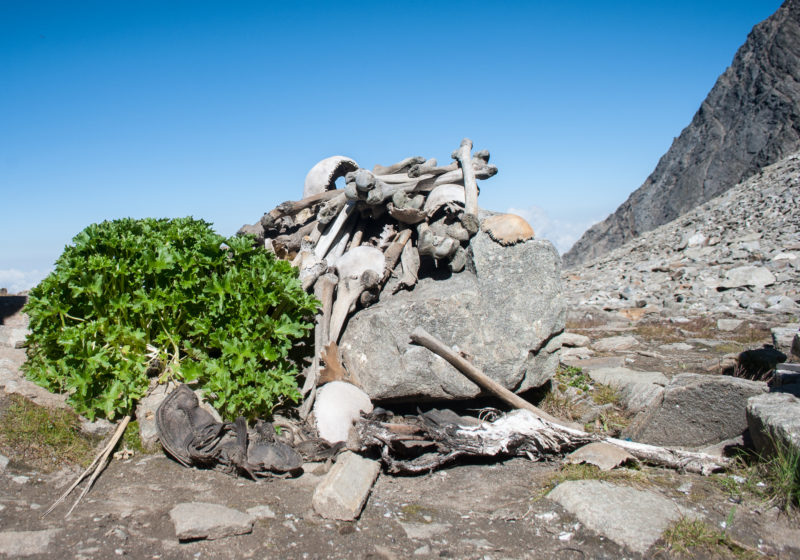
ROOPKUND, UTTARAKHAND, INDIA
When park ranger H. K. Madhwal discovered a lake ringed with thousands of human bones while walking in the Uttarakhand Himalayas in 1942, he raised a question that went unanswered for over 60 years: What killed the hundreds of people whose skeletons surrounded the lake? At first, the bones were thought to belong to Japanese soldiers who had stealthily crossed into India during World War II and perished in the high-altitude conditions. But carbon dating during the 1960s showed the estimated death date was wrong—very wrong. A broad range from the “12th to 15th century” was the best possible guess, but no cause of death could be established.
In 2004 the world got an answer to the mystery of Skeleton Lake. Radiocarbon testing at Oxford University narrowed the date of mass death to 850 BCE, give or take 30 years. Analysis of skulls showed that, no matter their stature or position, all of the people died in a similar way: from blows to the head. The bodies had wounds only on their heads and shoulders, indicating the blows came from directly above.
After dismissing earlier theories—which included ritual suicide and attacking hordes—the scientists reached an unexpected conclusion: The travelers died from a severe hailstorm.
Hail is rarely lethal. But trapped in a valley without shelter and given no warning of the storm’s severity, the 9th-century travelers could not escape the sudden barrage of tennis-ball-size spheres of ice.
Twelve hundred years after the storm, the green-tinged bones of hail victims still ring the lake, preserved alongside skulls and tattered shoes at an altitude of 16,500 feet (5,029 m).
The journey starts at Lohajung, a small pass where you can pick up essential supplies. Hire a guide and bring a mule or porter to help carry your belongings. The best time to go is in May or June, when there is no snow covering the lake and the skeletons are visible. You will need to be physically fit and prepared for high-altitude conditions.
N 30.262000 E 79.732000
4. Door to Hell
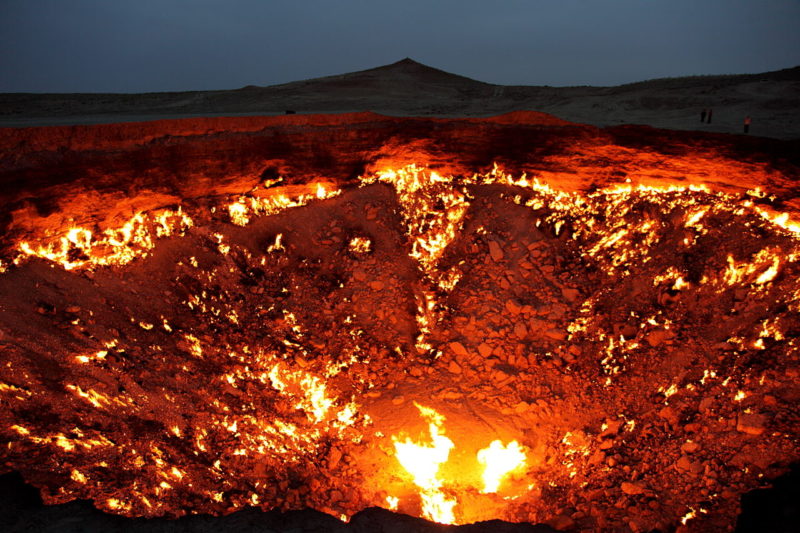
DERWEZE, AHAL, TURKMENISTAN
When darkness falls, an orange glow illuminates the dusty plains outside of Derweze, a settlement of 350 in the middle of the Karakum Desert. The source of light is the “Door to Hell,” a 200-foot-wide (61 m) crater that has been burning for over 45 years.
In 1971, Soviet geologists, looking for natural gas, accidentally burrowed into a huge cavern filled with methane, causing the ground to crumble and their drilling rig to collapse into the huge pit. With the pocket of gas punctured, poisonous fumes began leaking from the hole at an alarming rate. To avoid a potential environmental catastrophe, the geologists set the hole on fire. The crater has been burning ever since.
Following a visit to the Door to Hell in April 2010, Turkmen president Gurbanguly Berdimuhamedow recommended the hole be closed so the area’s rich gas reserves can be tapped safely. Thus far the crater remains untouched, but with new pipelines and increased international interest in Turkmen gas reserves, the Door to Hell may not be open for much longer.
The crater is 160 miles (257.5 km) north of the capital city of Ashgabat, where you can hire a guide to drive you to the desert.
N 40.252777 E 58.439444
5. Museum of Death
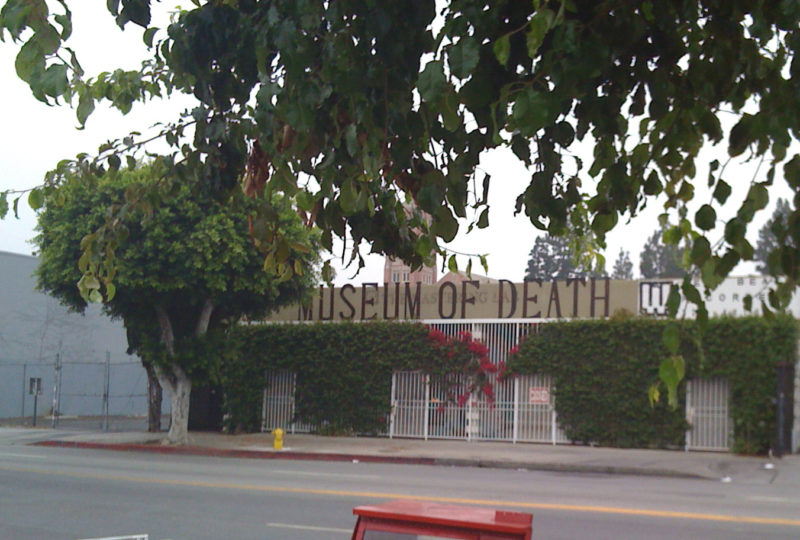
HOLLYWOOD, CALIFORNIA, U.S.A.
Your visit to the Museum of Death begins with a test: Look at the photo on the wall next to the front desk. It shows a man’s freshly mutilated body, parts of it scattered across a road following a truck crash. If the picture makes you feel queasy, this place is not for you.
Established in 1995, the museum is a graphic, shocking ode to the myriad ways humans shuffle off this mortal coil. A 45-minute self-guided tour through the small building takes in capital punishment, cult suicides, traffic accidents, and serial murders. A display of body bags, coffins, and mortician instruments serves as a reminder that death is the great equalizer.
Standout exhibits include the Heaven’s Gate room, a re-creation of the scene that greeted investigators when they entered a San Diego mansion in March 1997 to discover 39 cult members had committed suicide. Each person had swallowed a lethal dose of phenobarbital and—covered in a purple shroud and wearing brand-new Nikes—lay neatly on a bunk bed, believing their souls would be transported to a higher realm on an alien spacecraft. In the museum version, mannequins lie on a set of beds taken from the actual house. They wear shrouds and Nikes removed from two of the deceased followers.
High-profile cases such as the Black Dahlia, Charles Manson, and John Wayne Gacy receive name checks, but the more fascinating artifacts belong to lesser-known murderers. On one wall is a set of photos taken by a couple. The images depict the duo grinning at the camera as they hold up the shredded body parts of the man they have just killed. This being the days before digital cameras, the twosome were caught and charged with murder after they took the incriminating film to a lab to be developed.
6031 Hollywood Blvd., Hollywood. Take the metro to Hollywood and Vine and walk 2 blocks east.
N 34.101943 W 118.321201
6. Villisca Ax Murder House
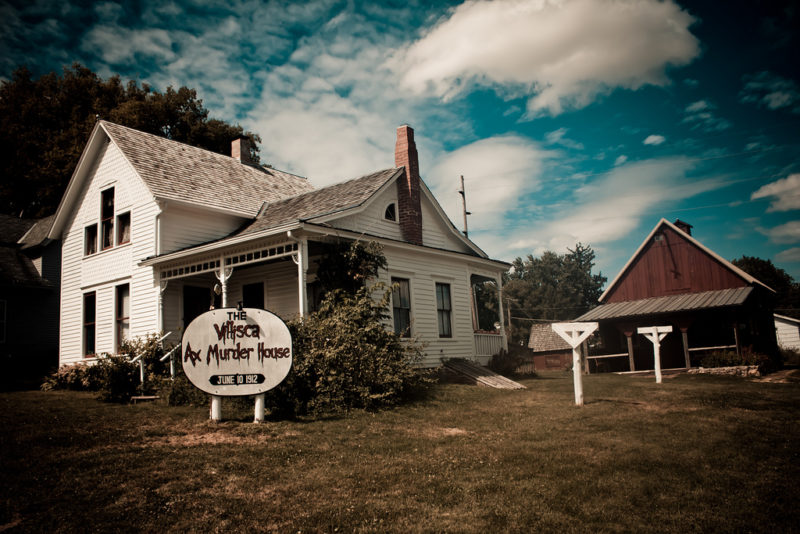
VILLISCA, IOWA, U.S.A.
For a unique overnight stay, book a night in the home where eight people were once slaughtered in their beds as they slept.
In 1912, this house belonged to the Moore family: married couple Josiah and Sarah and their young children, Herman, Katherine, Boyd, and Paul. On the night of June 9, the family returned from Children’s Day services at the local church, accompanied by two of the girls’ friends: eight-year-old Ina Stillinger and her twelve-year-old sister, Lena.
Sometime between midnight and 5 a.m., an unknown person entered the house and murdered every person inside by striking their head with an ax. From observations at the crime scene it appears that all were asleep at the time they were killed, apart from Lena, who exhibited a defensive wound on her arm and was positioned across her bed.
Over a century later, the case remains unsolved. The main suspect, traveling minister Reverend George Kelly, had taught at the church on June 9 and left town at approximately 5 a.m. the next day. He was tried twice but never convicted.
The Villisca Ax Murder House, as it is now bluntly known, was purchased in 1994 by Darwin and Martha Linn and restored to its 1912 state. You can tour the home by day, then spend the night in a room that was once a blood-soaked crime scene.
508 East 2nd Street, Villisca. All eight victims of the ax murders are at Villisca Cemetery, a 15-minute walk north of the house.
N 40.930704 W 94.973316
7. The Nutshell Studies of Unexplained Death
BALTIMORE, MARYLAND, U.S.A.
In 1943, Frances Glessner Lee began working on a series of detailed, dollhouse-style dioramas. Working at a scale of 1 inch to 1 foot, the 65-year-old forensics expert filled her minirooms with hand-sewn textiles, color-coordinated furniture, and bottles with hand-painted labels. Posed in each room was a minicorpse exhibiting just the right degree of decay.
Lee’s dioramas were known as the Nutshell Studies. Created to assist forensic science students at Harvard, they depicted murder scenes, suicides, and lethal accidents. The clues in Lee’s nutshells—such as blood spatter patterns, the position of the body, and the items found around it—allowed students to analyze and determine the nature of each grisly death.
To make each scene authentic, Lee read crime reports and police interviews to compile details. She was unflinching in her interior decoration: In one scene, “The Three-Room Dwelling,” a husband and wife lie dead in their bedroom. Crimson footprints separate them from the corpse of their blood-spattered baby.
All 18 nutshell dioramas are displayed at the Maryland Medical Examiner’s Office. The gory tableaus are still studied by detectives in training.
900 West Baltimore Street, Baltimore.
N 39.289109 W 76.632637
8. Witches’ Market
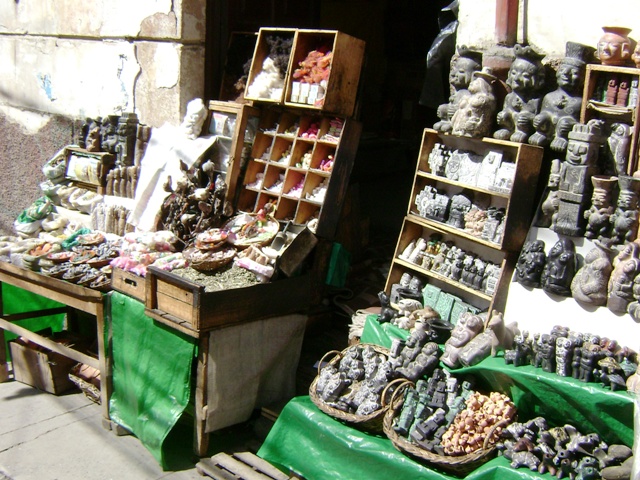
LA PAZ, BOLIVIA
Dozens of vendors line this street, selling folk remedies, dried reptiles, and llama fetuses that are said to bring prosperity and good luck. “Witches” wander through the market offering fortune-telling services, spiritual advice, and traditional medicine cures. If you’d like a glimpse into your future, or help with a physical or spiritual ailment, look for the people wearing dark hats.
Calle Linares, La Paz. Taxis, micros (minivans), and trufis (cars with specific routes) are all cheap ways of getting to this cobblestone street between Sagarnaga and Santa Cruz.
S 16.496624 W 68.138655
9. The Island of the Dolls
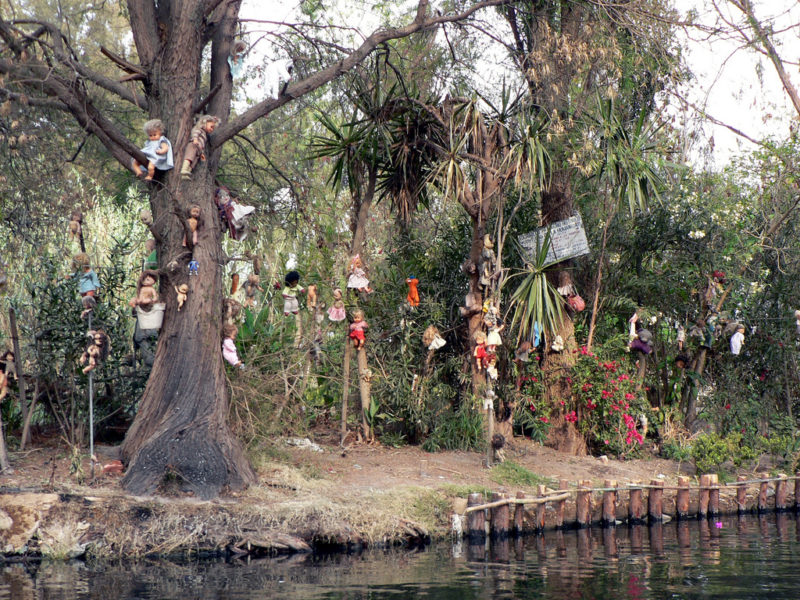
MEXICO CITY, MEXICO
As a gondolier steers you along Teshuilo Lake to La Isla de las Muñecas, you’ll see two giant teddy bears sitting sentry on the shore. Beyond them are the main attraction—hundreds of dirt-encrusted dolls nailed to trees, strung along wires, and pinned to a dilapidated wooden shack.
Some dolls are missing limbs. Others have spider webs forming in their eye sockets. Their faces have been bleached and discolored by the sun, and their hair is stringy and matted. Their clothes are gradually rotting away. Most are attached by their necks, their heads sagging forward, giving them the appearance of having been hanged.
Dolls began appearing on the island in the 1950s, when a man named Don Julian Santana Barrera, ostracized from his hometown for his religious preaching, left his wife and children and moved there to live in isolation. A local legend told of a girl who had drowned in the surrounding lake. Santana Barrera became fixated on her and was convinced that her spirit lingered on the island. In order to appease her, and to protect himself from any evil spirits lurking in the lake, he began collecting dolls from the trash and arranging them into makeshift memorials.
Over the next five decades, Santana Barrera collected hundreds of plastic children. An avid gardener, he traded produce for dolls and suspended them carefully from trees, wires, and the walls of his wooden hut. He continued to be haunted by the spirit of the drowned girl—though there is no evidence that the girl ever existed.
In 2001, Santana Barrera’s nephew, Anastasio Velazquez, came to the island to help his uncle plant pumpkins. As they fished in the canal, Santana Barrera, then 80, sang passionately, claiming that mermaids in the canal were beckoning to him. Velazquez left briefly to work on the garden. When he returned, he found Santana Barrera lifeless, lying facedown in the canal in the spot where the girl is said to have drowned.
Though the troubled man behind the dolls is gone, his unsettling creations live on. Velazquez keeps the private island open to visitors, many of whom bring dolls of their own as tributes for the “girl of the lake.”
Teshuilo Lake, Xochimilco, Mexico City. Get the metro line to Tasqueña station, then the light rail to Xochimilco, a district of canals and artificial islands. From there, walk to Cuemanco landing, where you can hire a gondola. Make sure the gondolier is willing to ferry you to the island, as it’s not part of the standard route. The trip takes about 2 hours.
N 19.272847 W 99.096510
10. Blood Falls
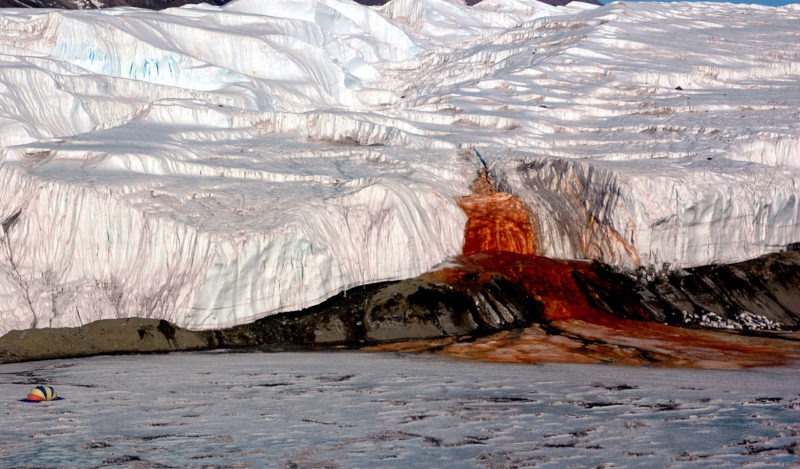
MCMURDO DRY VALLEYS, VICTORIA LAND, ANTARCTICA
Taylor Glacier is hemorrhaging blood—at least that’s what it looks like. On the east end of the frozen mass, a 5-story stream of rust-colored water flows into Lake Bonney, staining the ice.
This crimson water has been trapped beneath a glacier for 2 million years. Ocean water flooded East Antarctica 5 million years ago, creating a salty lake on the iron-rich bedrock. Taylor Glacier formed atop the lake, sealing it off from sunlight and oxygen and gradually burying it beneath 1,300 feet (396 m) of ice. Despite the absence of oxygen, the hidden reservoir of groundwater is rich with microbial life. At least 17 different microorganisms have been identified in Blood Falls’s high-salt, high-iron water, which is now rising through fissures in the glacier. When it meets the air, the water oxidizes, resulting in the bloodlike hue.
Beyond its striking appearance, Blood Falls is interesting to scientists because the glacier’s surviving microbes hint at the ecosystems that might be found on Mars and in other harsh, low-oxygen habitats.
The Dry Valleys are accessible only by helicopter from McMurdo Station, Scott Base, or via a cruise ship in the Ross Sea. Cruises depart from New Zealand.
S 77.716686 W 162.266765
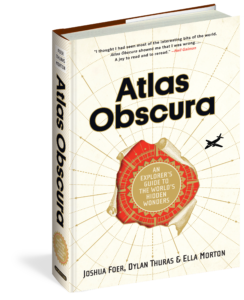 About the Book
About the Book
It’s time to get off the beaten path. Inspiring equal parts wonder and wanderlust, Atlas Obscura celebrates over 700 of the strangest and most curious places in the world.
Created by Joshua Foer, Dylan Thuras and Ella Morton, Atlas Obscura revels in the weird, the unexpected, the overlooked, the hidden and the mysterious. Every page expands our sense of how strange and marvelous the world really is. And with its compelling descriptions, hundreds of photographs, surprising charts, maps for every region of the world, it is a book to enter anywhere, and will be as appealing to the armchair traveler as the die-hard adventurer.
Anyone can be a tourist. Atlas Obscura is for the explorer.
Order Atlas Obscura today!
Amazon » Barnes & Noble » IndieBound » Workman »

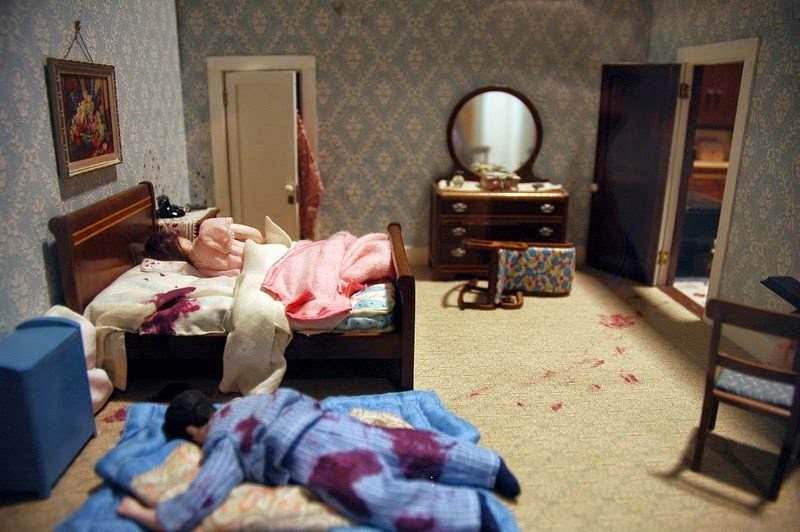

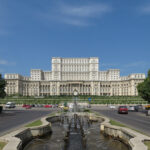


No Comments